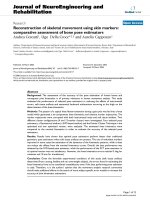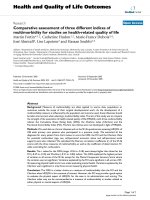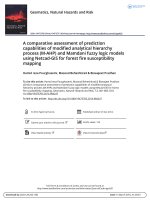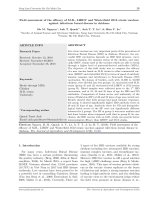Comparative assessment of performances of Vanaraja, Kamrupa and desi chicken reared by tribal community of lower Brahmaputra valley zone of Assam
Bạn đang xem bản rút gọn của tài liệu. Xem và tải ngay bản đầy đủ của tài liệu tại đây (172.18 KB, 7 trang )
Int.J.Curr.Microbiol.App.Sci (2020) 9(8): 2422-2428
International Journal of Current Microbiology and Applied Sciences
ISSN: 2319-7706 Volume 9 Number 8 (2020)
Journal homepage:
Original Research Article
/>
Comparative Assessment of Performances of Vanaraja, Kamrupa
and Desi Chicken Reared by Tribal Community of Lower
Brahmaputra Valley Zone of Assam
Mihir Sarma1*, Jitendra Saharia2, Prasanta Boro2*, Juripriya Brahma3 and R. Islam4
1
Poultry Science, 2Livestock Production Management, 3Veterinary Clinical Medicine,
Livestock Research Station, Assam Agricultural University, Mondira, Kamrup, Assam, India
4
Deptt. of AHD, BN College of Agriculture, AAU, Biswanath Chariali, India
*Corresponding author
ABSTRACT
Keywords
Vanaraja, Kamrupa,
Desi chicken, Body
weight, Mortality,
fertility,
Hatchability
Article Info
Accepted:
20 July 2020
Available Online:
10 August 2020
A study was undertaken to assess different productive and reproductive
performances of Desi, Kamrupa and Vanaraja chicken under traditional
system amongst tribal community of Lower Brahmaputra Valley Zone of
Assam. Information on mean body weight at various ages groups, age at
first egg, annual egg production, mortality rate, fertility and hatchability
were obtained from farmers under the study. Significant (P≤0.05)
differences were observed amongst the three breeds of chicken in terms of
body weight, egg production and egg weight. The age at first egg was
significantly (P≤0.05) higher in Desi chicken compared to Vanaraja and
Kamrupa. But, no significant (P≤0.05) differences were found among all
three groups of birds in terms of fertility, hatchability and mortality from
31st-52nd weeks of age except at the early age group. These evaluated
performances of birds will help farmers to rear the right choice of chicken
for their livelihood and also for sustainable backyard chicken farming in
their locality.
Introduction
Rearing of Desi chickens under backyard
system is a common phenomenon among the
resource poor and underprivileged families in
rural India, particularly among the tribal
masses. Backyard poultry is a manageable
and encouraging enterprise to improve the
socio-economic and nutritional status of rural
people especially landless and poor families
with low initial investment and high
economic return (Chakrabarti et al., 2014) as
well as it has been given more emphasis for
improving rural livelihood (Singh et al.,
2018). These birds support them substantially
for their livelihood and nutritional security.
2422
Int.J.Curr.Microbiol.App.Sci (2020) 9(8): 2422-2428
They produce meat and egg, which are the
only sources of high quality animal protein
among the villagers. Moreover, indigenous
chickens are hardy, resistant to most of the
common avian diseases, require almost no
inputs and adapt well in harsh climatic
condition.
However,
their production
potential is much lower due to inferior genetic
makeup. Further, the consumers prefer to
purchase local egg and meat than commercial
broilers and eggs. Local eggs and meat
always fetches a premium price over the
commercial counterparts. Hence, there is a
huge gap between demand and supply of local
poultry egg and meat among consumers.
Keeping this point in mind, different
multicoloured improved birds like Vanaraja,
Gramapriya, Kamrupa etc. have been
developed by different ICAR research
stations, SAUs’, private agencies etc. in India.
These multicoloured birds perform much
better even up to three times in terms of egg
and meat under similar backyard condition.
Under such circumstance, evaluation of such
improved chicken under traditional field
condition is the need of the hour to
recommend farmers better birds under agroclimatic condition of Assam for sustainable
economic improvement in rural farmers.
There is scanty of information on production
and productivity of Kamrupa and Vanaraja
birds in Lower Brahmaputra Valley Zone of
Assam. Hence, the present study was
undertaken to know various productive and
reproductive performances of these birds i.e
Vanraja, Kamrupa and Desi birds under
traditional system amongst tribal community
of Lower Brahmaputra Valley Zone of
Assam.
Materials and Methods
Study area
The study was carried out during the period
from December, 2018 to November, 2019 in
the tribal dominated areas of
Brahmaputra Valley Zone of Assam.
Lower
Selection and sampling
A total of 150 farmers were selected
randomly from 15 selected villages, 10
farmers from each village for the study under
the Tribal Sub-plant Project. Day old chicks
numbering ten each of Vanaraja and
Kamrupa were supplied to each farmer,
selected on the basis of their experience in
keeping a minimum 10-15 numbers of Desi
chicken in their backyard. The Vanaraja and
Kamrupa chicks were brooded under hover
brooder up to 21days of age. During the said
period, they were provided with ad libitum
broiler pre-starter crumbs and clean potable
drinking water. As per standard vaccination
schedule, the chicks were vaccinated against
Ranikhet and Gumboro diseases. The chicks
were let loose during day time after proper
brooding and were given supplemental
feeding for a week until they were able to
feed through natural feed resources.
Data collection
The data on body weights at hatch, 4, 8, 20,
40 and 52 weeks of age, age at first egg, egg
weights at 32, 40 and 52 weeks of age, egg
production up to 32, 40, 52 and 72 weeks of
age were recorded for the study. Mortality
rate was recorded at 0 to 5, 6 to 30 and 31 to
52 weeks of age.
Fertility and hatchability were studied using
500 numbers of eggs and 250 numbers from
each variety of Vanaraja and Kamrupa,
respectively. The eggs were collected within a
period of one week from different stocks and
were set in incubator. The fertility was tested
on 7th day of incubation by electric bulb and
infertile eggs were removed from the
incubator. Hatchability rate on TES and FES
was calculated after 21 days of incubation
period.
2423
Int.J.Curr.Microbiol.App.Sci (2020) 9(8): 2422-2428
Statistical analysis
The data so collected were tabulated and
analyzed by using SPSS version 17.0 as per
standard statistical methods (Snedecor and
Cochran, 1994) and expressed in mean±SE.
Duncan Multiple Range test of SPSS was
performed for mean statistical significant
difference.
Results and Discussion
Productive and reproductive performance of
Vanaraja, Kamrupa and Desi chicken are
tabulated in Table 1. Weight of Vanarja,
Kamrupa and Desi chicks at hatch are
36.12±0.34, 30.21±0.40 and 24.27±0.51,
respectively. At 52nd week of age, weight of
Vanarja, Kamrupa and Desi birds are
3490.77±11.24,
1957.34±9.71
and
1408.35±8.12, respectively. Weight of the
above birds at 4th, 20th, 40th and 52nd weeks of
age are presented in Table 1.
Age at first egg in Vanraja, Kamrupa and
Desi birds are 186.51±1.32, 189.20±1.08 and
197.30±1.02, respectively (Table 1).
Numbers of eggs produced by Vanraja,
Kamrupa and Desi birds at 32nd weeks of age
are 33.23±0.12, 21.98±0.06 and 11.23±0.04,
respectively and at 72nd weeks of eggs are
162.02±1.02, 140.50±0.80 and 76.31±0.70,
respectively (Table 1).
Egg weight at 32nd weeks of age of the birds
under study is 47.82±0.22, 38.40±2.30 and
27.85±0.04, respectively. Weight of the eggs
produced by the birds at 72nd weeks of age are
61.24±1.08, 48.23±1.31 and 41.14±1.03,
respectively (Table 1).
Higher mortality rates were observed in the
above mentioned improved varieties during
early part of their life (0-30th weeks of age)
whereas lower mortality rate at later part of
life (31-52nd weeks of age). No significant
(P≤0.05) difference among the three groups of
birds were noticed in terms of fertility and
hatchability (Table 1).
Body weights
The data on mean body weights showed
significant (P<0.05) difference amongst
Vanaraja, Kamrupa and Desi birds, at similar
ages (Table 1). The mean body weights were
significantly (P<0.05) higher in Vanaraja
followed by Kamrupa and Desi in similar
ages. The higher mean body weights recorded
in Vanaraja and Kamrupa birds than Desi
chicken might be due to superior germplasm
utilized in the development of Vanaraja and
Kamrupa. Islam et al., (2014) also reported
similar mean body weights in case of
Vanaraja and indigenous chicken in backyard
system of rearing. Kalita et al., (2016) also
observed similar body weight trends in
Kamrupa with ages under similar condition.
Daida et al., (2013) reported much lower
body weight in Vanaraja at 20 weeks of age.
However, Bharali et al., (2020) reported
comparatively higher that body weight of
Vanaraja birds at 40th week of age (3080.55 ±
143.22 grams). The differences in body
weights within same germplasm might be due
to
different
managemental
condition,
supplemental feeding etc.
Age at first egg production
The mean age at first egg recorded in
Vanaraja (186.51±1.32 days), Kamrupa
(189.20±1.08 days) birds were significantly
(P≤0.05) lower than Desi (197.30±1.02 days)
bird (Table 1). The significant difference of
mean age at first egg among Desi, Vanaraja
and Kamrupa might be due to differences in
the genetic constituent. The present findings
agreed with the results of several workers
(Islam et al., 2014; Sarma et al., 2018 and
Choudhary et al., 2019) in case of Vanaraja.
2424
Int.J.Curr.Microbiol.App.Sci (2020) 9(8): 2422-2428
The age at first egg in Kamrupa chicken
observed in the present study was almost
similar with Kalita et al., (2016). Deka et al.,
(2014) also recorded lower mean age at first
egg in Vanaraja (178.13±0.79 days) and
indigenous chicken (191.25±1.46 days) under
backyard system. Besides, Bharali et al.,
(2020), Kumar et al., (2018), Sree et al.,
(2017) and Saikia et al., (2017) reported
lower age of Vanraja hen at first egg laying as
162.55 ± 11.43 days, 179.3 days, 152 days
and 181.05±1.52, respectively.
Table.1 Productive and reproductive performance of Vanaraja, Kamrupa and Desi chicken
Parameters
Vanaraja
Kamrupa
Body weights (g) at
36.12±0.34 a
30.21±0.40 b
Hatch weight
a
th
539.12±23.17
220.61±11.10 b
4 week
756.34±5.42 a
502.12±3.20 b
8th week
1690.27±11.32 a
1320.34±9.34 b
20th week
a
th
2958.52±12.18
1850.20±10.30 b
40 week
3490.77±11.24 a
1957.34± 9.71b
52nd week
186.51±1.32 a
189.20±1.08 a
Age at first egg (days)
Egg production numbers up to
nd
33.23±0.12 a
21.98±0.06 b
32 week
52.07±0.31a
41.34±0.32 b
40th week
87.28±1.01a
80.40±0.62 b
52nd week
a
162.02±1.02
140.50±0.80 b
72 week
Egg weight (g)
nd
47.82±0.22 a
38.40±2.30 b
32 week
a
th
53.97±0.24
41.50±0.21b
40 week
57.80±0.27 a
43.60±0.10 b
52nd week
61.24±1.08 a
48.23±1.31b
72nd week
Mortality (%)
th
11.33±1.42 a
7.85±1.16 b
0-5 week
3.24±0.23 a
2.04±0.43 b
6-30th week
1.08±0.04 a
1.21±0.11a
31-52nd week
a
91.21±6.43
90.71±5.41a
Fertility (%)
89.13±4.12a
88.53±4.20 a
Hatchability on TES (%)
92.16±1.32a
91.43±1.24 a
Hatchability on FES (%)
Desi
24.27±0.51c
164.29±5.18 c
365.13±2.64 c
778.13±4.21c
1240.41±8.21c
1408.35±8.12 c
197.30±1.02 b
11.23±0.04 c
25.62±0.16 c
41.47±0.53 c
76.31±0.70 c
27.85±0.04 c
31.08±0.08 c
35.98±0.14 c
41.14±1.03 c
8.04±0.86 b
1.84±0.33 b
1.04±0.23 a
90.40±4.97 a
88.32±2.75 a
91.16±2.12 a
Means bearing similar superscripts in a row do not differ significantly.
Egg production
The mean egg production differed
significantly
(P≤0.05)
amongst
Desi,
Vanaraja and Kamrupa chicken, which might
be due to differences in the genetic makeup of
birds. The mean egg production was
significantly higher in Vanaraja followed by
Kamrupa and Desi chicken at different ages
under backyard system. The egg production
up to 52nd week of age in Vanaraja reported
in the present study was in accordance with
the finding of Choudhary et al., (2019).
Similarly, mean egg production in Desi
chicken at 72 weeks of age was also
corroborated the finding of Sarma et al.,
2425
Int.J.Curr.Microbiol.App.Sci (2020) 9(8): 2422-2428
(2018). However, lower corresponding value
of egg production (149.47± 4.46 numbers) in
Vanaraja up to 72 weeks of age was recorded
by Niranjan et al., (2008). Kalita et al., (2016)
recorded much lower annual egg production
in Kamrupa than the present findings, which
might be due to availability of feed resources
in the study areas.
Egg weight
The data on mean egg weight also showed
significant (P≤0.05) difference amongst Desi,
Vanaraja and Kamrupa birds (Table 1). The
weight of Vanaraja, Kamrupa and Desi eggs
were 57.80±0.27, 43.60±0.10 and 35.98±0.14
respectively at 52nd week of age. The present
findings were in accordance with the findings
of Islam et al., (2014) in Vanaraja and
indigenous chicken and Niranjan et al.,
(2008) in Vanaraja chicken. In contrast to the
present findings, Deka et al., (2014) reported
much lower egg weight in Vanaraja
(51.08±0.36) and 59.06 ± 0.42 g at 40 and 72
weeks of age respectively and it was 36.12 ±
0.62 and 41.07 ± 0.48g at 40 and 72 weeks of
age respectively in indigenous chicken under
backyard system These variation in egg
weight might be due to supplemental feeding,
genetic make-up and differences in
management. Higher egg weight at 40th week
(57.06 g) and 72nd week (62.35 g) was
recorded by Niranjan et al., (2008b) in
Vanaraja chicken. The mean egg weight
observed in Kamrupa chicken in the present
study was much lower than the weight
recorded by Kalita et al., (2016) at 40 weeks
of age.
Mortality
The significantly (P≤0.05) higher mortality
rates were recorded in the above mentioned
improved varieties than the Desi chicks
during early part of their (0-30th weeks of
age). The lower mortality rate in Desi chicks
than the improved chicks might be due to
more hardiness and proper natural brooding
by their broody mother whereas the higher
mortality rate in improved chicks, Vanraja
and Kamrupa might be due to faulty brooding
arrangements like cold shock and huddling
The mortality at later part of life (31-52nd
weeks of age) was mostly due to predators in
all the cases and no significant (P≤0.05)
difference were noticed among three groups
(Table 1). The present findings were well in
agreement with the findings of Bhattacharya
et al., (2005), Niranjan and Singh (2005) and
Islam et al., (2014) who had reported the
mortality rate in the range of 0-15 percent for
birds reared under similar conditions. But,
Zuyie et al., (2009) reported much lower
mortality in Vanaraja chicken. Also, much
lower mortality rate was reported by Kalita et
al., (2016) in Kamrupa than the present
findings up to 40th week of age.
Fertility and Hatchability
While recording, per cent fertility and
hatchability, there was no significant (P≤0.05)
difference among the three groups of birds
(Table 1). The present findings were in
accordance with the findings of Islam et al.,
(2014). Kalita et al., (2012) and Deka et al.,
(2017) also reported higher rate of
hatchability as as 81-100%) and 89.07±4.11,
respectively in indigenous chicken of Assam.
In contrast to the present findings, Roy et al.,
(2018) reported lower hatchability of fertile
eggs in Vanaraja birds (85.22%) and
indigenous birds (86.98%). Besides, Kumar et
al., (2005) reported lower hatchability as 72.6
per cent in Vanaraja birds under traditional
system of rearing in Manipur. Kalita et al.,
(2016) also reported similar fertility and
hatchability in Kamrupa in Assam.
From the present study, it may be concluded
that Vanaraja and Kamrupa birds are well
suited and adapted to our agro-climatic
2426
Int.J.Curr.Microbiol.App.Sci (2020) 9(8): 2422-2428
condition of Assam, especially Lower
Brahmaputra Valley Zone of Assam and can
be reared by farmers in small scale backyard
system along with Desi birds. Thereby, such
initiatives can usher livelihood, nutritional
and food security to the farmers as well as
sustainable production.
Acknowledgement
The authors are thankful to the Directorate of
Research,
(Vety.),
AAU,
Khanapara,
Guwahati-22 for their necessary continuous
support and guidance to carry out the research
work. The authors are also thankful to the
farmers for providing various data for the
study.
References
Bhattacharya, M., Buragohain, R., Ahmed, F.
A., Pathak, P. K. and Ghosh, M. K. 2005.
Laying performance of Vanaraja birds in
high altitude areas of Arunachal Pradesh
under backyard system of rearing.
Proceedings of XXIII Annual Conference
and National Symposium of Indian Poultry
Science Association. 2-4 February,
Hyderabad, India, 2: 369 (Abstr.).
Bharali, D., Borah, D., Rajbonshi, P. and Dutta,
L. J. 2020. Study on Adaptability,
Productive Performance and Constraints of
Vanaraja Birds in Backyard System of
Rearing at Udalguri District of Assam,
India. International Journal of Current
Microbiology and Applied Sciences, 9 (3):
986-99.
Chakraborti, A., Dey, A. and Barari, S.K. 2014.
Backyard Poultry farming-a source of
better livelihood for rural farmers.
Krishisewa.
/>k/410-backyard
poultry
farming.html/12.04.2019.
Choudhary, R.K., Roy, M.K. and Sohane, R.K.
2019. Livelihood upliftment of tribal
farmers through backyard poultry farming
intervention in Kishanganj district of
Bihar. Journal of AgriSearch, 6: 90-92.
Chutia, H. (2010). Study on some productive
and reproductive traits of indigenous
chicken of Dhemaji district of Assam. M.
V. Sc. Thesis, Assam Agricultural
University, Khanapara, Guwahati, Assam,
India.
Daida K, Preetham VC, Reddy VR and Rao
STV. 2013. Growth performance and
liveability of Rajasree birds on farm and
field level. In Compendium 2: XXX
IPSACON, National Symposium on
Poultry Production: Feed, Food and
Environmental Safety, 22-23 November,
2013, CARI, Izatnagar, Bareilly, India.
pp.218.
Deka, P., Sarma, M., Nath, P. J., Borgohain, R.,
Mahanta, J. D., Deka, B. and Phukon, M
2014. Production performance of Vanaraja
bird under traditional system of rearing in
Assam. International Journal of Livestock
Research, 4(2): 81-85.
Deka, B.C., Deka, C.K., Islam, R., Hussain, M
and
Paul,
A.
2017.
Production
performance of improved backyard rural
poultry in NICRA village of Dhubri
district of Assam. International Journal of
Chemical Studies, 5(3): 802-804.
Islam, R., Kalita, N. and Nath, P. 2014.
Comparative performance of Vanaraja and
Indigenous chicken under backyard system
of rearing. Journal of Poultry Science and
Technology, 2 (1): 22-25
Kalita, N., Islam, R., Pathak, N. and Chutia, H.
2012. Hatchability and mortality of
indigenous chicken of Assam. Indian
Veterinary Journal, 89: 35-36.
Kalita N, Pathak N and Ahmed M. 2016.
‘Kamrupa’- A new dual chicken variety
for farmers of Assam and North- East
India. Indian Journal of Animal Sciences,
86: 686-690.
Kumar, Sanjay., Kumar Sushil and Kumar ,
A.K. 2018. Comparative Evaluation of
Grampriya and Vanraja with Local Desi
Bird
in
Dumka
District
Int.J.Curr.Microbiol.App.Sci
Special
Issue-7: 3700-3705.
Kumar, S., Ngachan, S. V., Sunder, G. S. and
2427
Int.J.Curr.Microbiol.App.Sci (2020) 9(8): 2422-2428
Devi, N. K. 2005. Production performance
of Vanaraja birds under traditional system
of rearing in Manipur. In: Proc. of 23rd
Annual Conf. and National Symp.
IPSACON, held on Feb, 2-4; Hyderabad,
India, 2: 382
Kumaresan, A., Bujarbaruah, K. M., Pathak, K.
A., Chhetri, B., Ahmed, S. K. and
Haunshi, S. 2008. Analysis of a village
chicken
production
system
and
performance of improved dual purpose
chickens under a subtropical hill agroecosystem in India. Tropical Animal
Health and Production, 40: 395-402.
Niranjan, M., Sharma, R. P., Rajkumar, U.,
Reddy, B. L. N., Chatterjee, R. N. and
Bhattacharya, T. K. 2008. Comparative
evaluation of production performance in
improved chicken varieties for backyard
farming. International Journal of Poultry
Science, 7: 1128- 1131.
Niranjan, M. and Singh, N. P. 2005.
Performance of Gramapriya under
intensive and free- range conditions of
Tripura. Proceedings of XXIII Annual
Conference and National Symposium of
Indian Poultry Science Association. 2-4
February, Hyderabad, India, 2: 366
(Abstr.)
Roy, Amitava., Datta Sanjoy., Roy, Partha
Sarathi., Biswas, Sukanta and Mishra,
Sidharth Prasad. 2018. Comparative
Assessment of Production and Hatchability
Performance of Vanaraja, Rhode Island
Red and Indigenous Poultry Birds under
Backyard Rearing System at West Bengal.
International Journal of Livestock
Research. 7(8): 296-303.
Saikia, A.K., Gogoi, G and Neog, M. 2017.
Productive and Reproductive Performance
of Vanaraja Birds Reared by Tribal
Community of Dhemaji District of Assam.
J Krishi Vigyan 6(1): 162-165.
Sarma, M., Islam, R., Borah, M.K., Sharma, P.,
Mahanta,
J.D.,
Kalita,
N.
and
Bhattacharyya, B.N. 2018. Comparative
performance of Vanaraja, Srinidhi and
Desi chicken under traditional system
among tribal community of Assam. Indian
Journal of Animal Research, 52(10):15181520.
Snedecor, G. W. and Cochran, W. G. 1994.
Statistical Methods. 6th Edn, Oxford and
IBH Publishing Co. Calcutta.
Singh, Simran., Chakraborty, D., Altaf, Sahil.,
Taggar, R.K., Kumar, N and Kumar, D.
2018. Backyard poultry system: A boon to
rural livelihood. International Journal of
Fauna and Biological Studies, 5(1): 231236.
Sree, E. K., Nirmala, T. V and Reddy, R.V.S.K.
2017. Comparative performance of
different varieties of chicken under
backyard system of rearing in tribal and
rural areas of west Godavari District, A.P.
International
Journal
of
Science,
Environment and Technology, 6(2):1100 –
1104.
Zuyie, R., Sharma, V. B., Bujarbaruah, K. M.
and Vidyarthi, V. K. 2009. Performance of
Vanaraja birds under intensive system of
rearing at different altitude in Nagaland.
Indian Journal of Poultry Science, 44 (3):
411-413.
How to cite this article:
Mihir Sarma, Jitendra Saharia, Prasanta Boro, Juripriya Brahma and Islam, R. 2020.
Comparative Assessment of Performances of Vanaraja, Kamrupa and Desi Chicken Reared by
Tribal
Community
of
Lower
Brahmaputra
Valley
Zone
of
Assam.
Int.J.Curr.Microbiol.App.Sci. 9(08): 2422-2428. doi: />
2428









